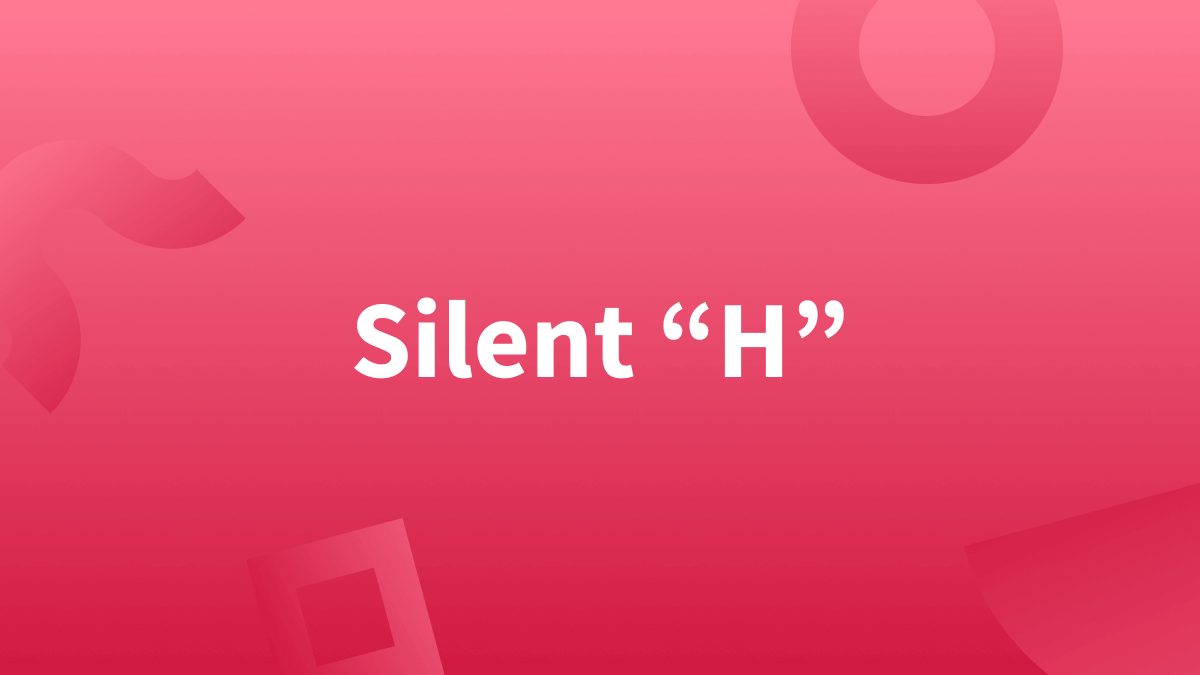Correct Use
- A silent “h” can be found at the beginning (honor), middle (aghast), or end (stomach) of words.
- An “h” can be silent on its own, or as part of a consonant digraph (a combination of letters that produce one single sound).
- A few examples of words with a silent “h” are: echo, honest, psychic, and while.
Silent letters can make proper pronunciation a challenge because most of the time, there are no patterns or rules one can follow. Knowing which words have silent letters takes years of practice and familiarization. In this article, we’re going to teach you about one silent letter in particular: the silent “h.”

“Silent H” Rules
Single “Silent H”
With a single silent “h” there are usually no patterns or rules to follow that can help you distinguish whether it’s silent or not. Consider the following words:
- ham /hæm/
- heap /hiːp/
- house /haʊs/
In these three words, the “h” is pronounced, but in the following, it’s silent:
- hour /ˈaʊər/
- heir /ɛr/
- honest /ˈɑnəst/
However, there are two circumstances when the single silent “h” is predictable: when it appears between two vowels (annihilate /əˈnaɪəˌleɪt/), and when it ends a word right after a vowel (cheetah /ˈtʃiː.t̬ə/).
“Silent H” in Consonant Digraphs
A consonant digraph is a combination of consonants that represent one sound. The letter “h” appears in a few consonant digraphs: “ch”, “gh”, “ph”, “th,” “sh”, and “wh”. Here, we’ll only be focusing on the digraphs in which the “h” isn’t explicitly pronounced.
CH /k/
The digraph “ch” can produce three different sounds. One of them is the hard “c” or “k” sound (/k/).
chemistry /ˈkɛməstri/
chord /kɔrd/
anchor /ˈæŋkər/
technology /tɛkˈnɑləʤi/
This digraph is usually found at the beginning or in the middle of words.
It’s important to note that certain words are sometimes pronounced differently in British and American English. For example, in British English, schedule is often pronounced /ˈʃɛdjuːl/ (like the “sh” in shoot).
GH /g/
“Gh” can also produce multiple sounds. One of them is the hard “g” sound, like in ghetto /ˈgɛtoʊ/, ghost /goʊst/, and spaghetti /spəˈgɛti/. In other words, the “gh” is silent, like in fought /fɔt/, caught /kɑːt/ high /haɪ/, and thigh /θaɪ/.
WH /w/
Another consonant digraph in which the “h” can become silent is in “wh.” Here are some examples:
why /waɪ/
wheel /wiːl/
white /waɪt/
Please Note
Most English dialects pronounce the “wh” digraph as /w/, like in “what.” Very rarely though, some dialects do slightly pronounce the “h,” which makes the “wh” digraph produce the /hw/ sound. However, it’s most common for the “h” to be silent when a word has this digraph.
The English language can be hard to understand, let alone learn as a second language. Silent letters make it even more perplexing. Typically, there might not be rules to follow that can help you get the spelling of a word with a silent letter right. That’s why it’s beneficial to have an intelligent writing assistant like LanguageTool. Not only will it correct misspelled words, but it’ll also fix any grammar errors, easily provide synonyms, and suggest stylistic improvements.

